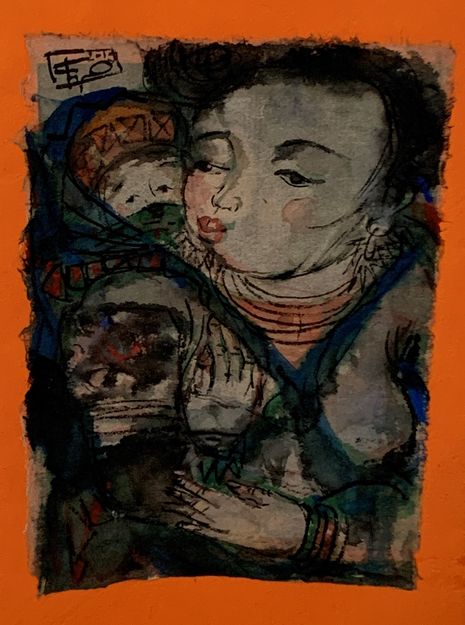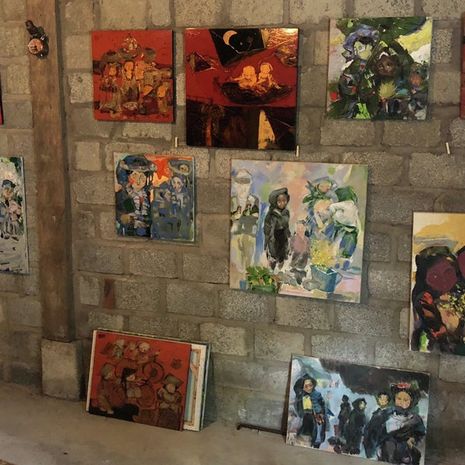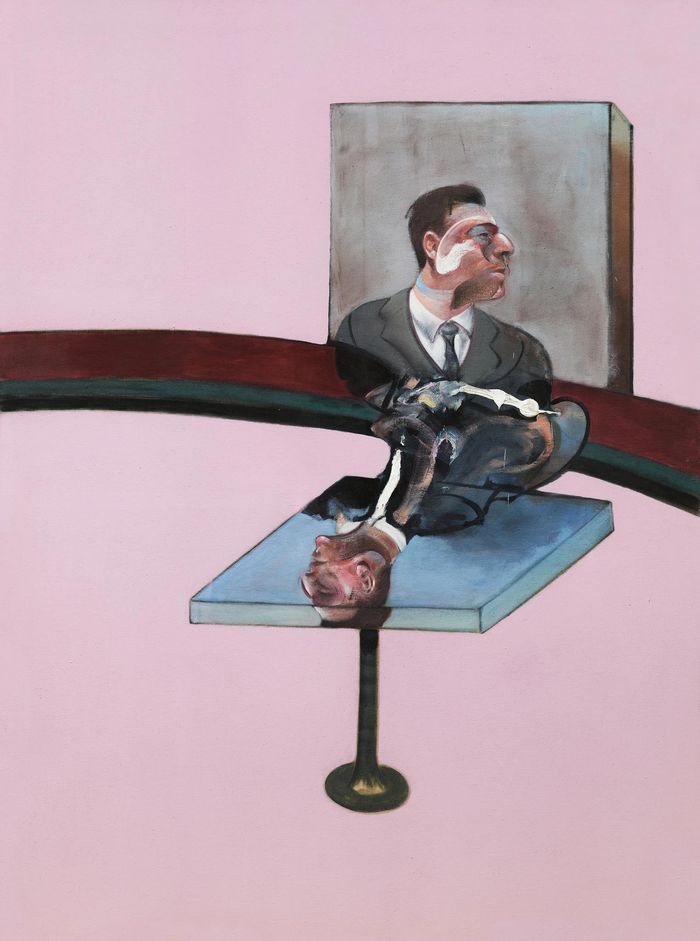Art Bluesun Studio – Capturing the experience of the modern Vietnamese woman
Erin Argun recalls a chance encounter with artist Pham Thanh Nga and her depictions of “women brought together through sentiment and shared experience” in the small Vietnamese village of Ta Van.

I keep on my desk a small watercolour study of a mother and child, beset on an electric orange piece of thin card - a ‘souvenir’ picked up last summer in Ta Van in north-western Vietnam. I rather scrupulously protected the little sketch in my bag throughout cramped overnight bus journeys, tumultuous hostels, and the sixteen-hour journey home. Cringe-worthy as it may seem (and I promise I wasn’t on my gap-yah), the painting has never really been a souvenir to me: it is a vehicle back to a peculiar place, and to the dimly lit and precarious studio of Pham Thanh Nga, and her husband Nguyen Van Trun.
In Art Bluesun Studio, far from the havoc of the city, Nga seems to capture a sense of the true experiences of the modern Vietnamese woman.
Ta Van is a small village set within the valley of Muong Hoa; rice paddy fields run in stretches across the landscape like stairs reaching down into the centre of domesticity. After being in the chaotic city of Hanoi a few days prior, arriving in this sparsely populated, overwhelmingly green gulf seemed like a well-deserved recentering: especially after a tumultuous thirteen-hour bus journey. Secluded and noiseless, save for the unyielding rain, the village very soon showed itself to be a tranquil breeding ground for material culture.
Women and young girls adorned in vibrant hand-stitched garb, laden with patterned bags, purses and bracelets to sell to tourists, roamed up and down the winding toe-paths of the village. In a flurry of colour and clanging of jewellery in their loot, young girls (some no older than seven) would charge towards my companion and myself, eager to share with us their eccentric textiles: no two quite the same. The village is inundated with workshops where these fabrics are stitched together; older women (likely the mothers and grandmothers of their retailers) sit on plastic stools outside canopied shops, using recycled threads to work up their designs, chatting and laughing through their labour.

By the time we had explored about three of these workshops and hidden from the rain in a café-come-bar, it was becoming dark. A murky fog descended down the valley, rendering those green steps invisible. When the rain had become just about light enough to endure, we trudged back in our soggy shoes and continued our exploration of the village.
Nga shows her visitors women brought together through sentiment and shared experience.
Ta Van becomes, somehow, a different place entirely at night. The day's work is done; hanging street lights switch on and families cluster around their television sets. One neon pink light outside a small, modest-looking building seemed to pierce through the evening gloom, and a quick beeline was made towards the sign. The double doors to the building were open, and inside there was a table with a round, lacquer portrait illuminated by a filament bulb hanging above it. As we walked into the studio, light seemed to dance across the surface of glossy paintings, luminous with gold and bold pigments. Sitting at a small table in a dark corner was Pham Thanh Nga. Paints and brushes littered over the tabletop, she talked to us as she worked on a series of small lacquer portraits of small children and women.
Nga was warm and talkative, eager to tell the stories of the women she primarily portrays. My friend and I pointed towards the piece we had been eyeing, and asked her to tell us its story. A young woman was clad in fabric (not dissimilar to those worn by the weavers outside), and around her were her children. This was not however, a mere family portrait. The woman’s expression, rather like that of the woman in my little drawing, was rather sombre; there was a certain weight hanging about her in a scene which should have been one of joy. Nga explained this woman to be just sixteen-years-old, married and already with children, and spoke of the woman with a steady sense of remorse. Other works, however, pictured women in states of happiness: old women wearing the jewels they had illuminated throughout their lives (captured brilliantly by Nga’s lacquer) and, perhaps her most important muse, her late mother.
In Art Bluesun Studio, far from the havoc of the city, Nga seems to capture a sense of the true experiences of the modern Vietnamese woman. With a focus on the maternal compassion, perhaps best exemplified in her depictions of her mother, Nga shows her visitors women brought together through sentiment and shared experience. Hers is an outlook nurtured by her position in Ta Van; the dominant colours of her paintings are mirrored by those threaded together on the winding streets outside.
When I look at the painting on my desk, I’m reminded of this village of evocative and tangible colour, seemingly pieced together by women and documented so exquisitely by Thanh Nga.
Art Bluesun Studio has recently opened a group exhibition titled “Spring Is Coming” at 16 Ngo Quyen Street, Hanoi.
 News / Eight Cambridge researchers awarded €17m in ERC research grants27 December 2025
News / Eight Cambridge researchers awarded €17m in ERC research grants27 December 2025 News / Downing investigates ‘mysterious’ underground burial vault 29 December 2025
News / Downing investigates ‘mysterious’ underground burial vault 29 December 2025 Lifestyle / Ask Auntie Alice29 December 2025
Lifestyle / Ask Auntie Alice29 December 2025 Sport / Hard work, heartbreak and hope: international gymnast Maddie Marshall’s journey 29 December 2025
Sport / Hard work, heartbreak and hope: international gymnast Maddie Marshall’s journey 29 December 2025 Interviews / Meet Juan Michel, Cambridge’s multilingual musician29 December 2025
Interviews / Meet Juan Michel, Cambridge’s multilingual musician29 December 2025










